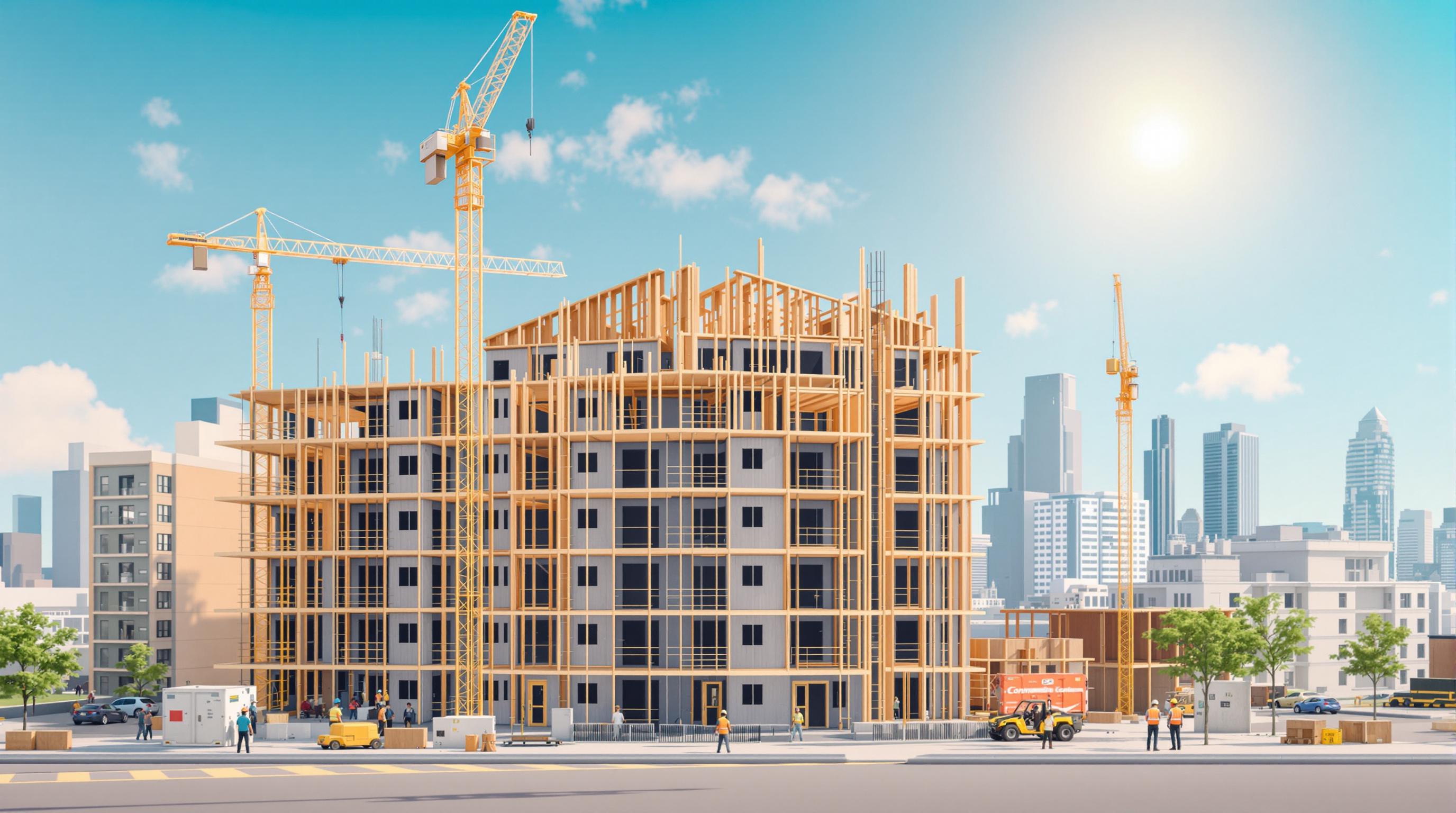Building on Nova Scotia’s South Shore means balancing coastal beauty, heritage preservation, and growing housing demand. Here’s a quick summary:
- Bridgewater: A growing business hub with near-zero vacancy rates. Major developments include 886 new residential units and infrastructure upgrades.
- Lunenburg: A UNESCO World Heritage Site where strict heritage rules shape construction, preserving its 18th-century charm.
- Mahone Bay: A picturesque town attracting retirees and remote workers, driving residential growth.
Key Considerations:
- Follow strict architectural standards and building codes, especially for coastal and heritage areas.
- Plan for weather-resistant construction to handle Atlantic conditions.
- Secure permits early to meet zoning and heritage requirements.
Whether you’re investing in housing, short-term rentals, or community projects, understanding these unique requirements is essential for success.
Key Communities: Development Profiles
Bridgewater: Business and Services Hub
Bridgewater stands out as the commercial centre of the South Shore, offering plenty of opportunities in its revitalized downtown. The town follows its Downtown and Waterfront Master Plan, which includes initiatives like the King Street Architectural Control Area façade improvement program and the "Take Back The Riverbank" project that led to the creation of Pijinuiskaq Park [2]. These efforts aim to blend modern upgrades with respect for local heritage, influencing development in nearby areas.
Lunenburg: Preserving Heritage in Development
Lunenburg’s designation as a UNESCO World Heritage Site comes with specific building rules. Known as North America’s best-preserved planned British colonial settlement, the town retains its original rectangular grid and iconic 18th-century architecture [3]. Any new construction is limited to four storeys and must meet strict heritage design criteria. Additionally, any archaeological finds during development must be reported to the provincial Department of Communities, Culture and Heritage [3].
Mahone Bay: Expanding Residential Appeal
Mahone Bay blends historic charm with modern conveniences, earning it a spot as one of Canada’s most picturesque towns [4]. Its growing popularity among retirees and remote workers fuels residential development, drawn by the town’s protected harbour, active arts community, and year-round events like the Scarecrow Festival and Season of Father Christmas [4]. This mix of coastal living and cultural vibrancy makes it an increasingly desirable place to live.
Construction Requirements and Standards
Architectural Standards
Building on Nova Scotia's South Shore requires strict compliance with provincial and local architectural regulations. The Nova Scotia Building Code Regulations incorporate key national codes, including the National Building Code of Canada 2020, the National Energy Code of Canada for Buildings 2020, and the National Plumbing Code of Canada 2020 [5]. In areas like Lunenburg's UNESCO district, maintaining historical accuracy is critical while also meeting modern safety standards. Be sure to consult local guidelines to align your designs with both heritage preservation and current building practices. These steps are crucial for addressing the unique challenges of coastal construction in this region.
Coastal Construction Methods
The South Shore’s exposure to Atlantic weather demands construction methods that can handle salt spray, high winds, and severe storms. The Nova Scotia Building Code Regulations require inspections or tests to confirm compliance [5]. Common coastal construction practices include:
- Using corrosion-resistant materials
- Performing advanced wind-load calculations
- Ensuring proper drainage systems
- Installing weatherproofing systems and storm-rated windows and doors
These measures are essential for creating structures that can endure the harsh coastal environment.
Permit and Zoning Guide
Before starting construction, it’s important to secure all necessary permits in line with the Building Code Regulations and local zoning bylaws. For heritage properties, additional requirements under the Heritage Property Act and Municipal Government Act must be followed. According to the regulations:
"if a heritage building, or part thereof, is undergoing a change in occupancy classification, the owner may choose the alternate compliance methods for existing buildings in Schedule D, or a combination of those methods and the Code" [5]
Additionally, building officials may delay issuing permits until all relevant environmental and heritage conditions are fully satisfied [5].
sbb-itb-16b8a48
Building a Legacy: A Journey Through My Architectural ...
Market Analysis and Trends
The South Shore market continues to show strong demand and targeted growth opportunities. In Bridgewater, the pressing need for housing has led to the development of 886 multi-unit and townhouse units. These projects are designed to adapt to market conditions and timelines as needed [1].
Short-term rentals are also becoming a popular investment focus, aligning with these market trends.
Short-Term Rental Development Guide
Short-term rentals can deliver impressive returns. For instance, a Halifax property generated $8,700 in monthly rental income with a construction cost of $415,700 (around $184 per square foot) within just 10 months [6].
"I was prepared for delays, but Helio delivered rapid, full-booking results within a month." - Lloyd L., Property Owner [6]
This example highlights how streamlined design and cost-effective planning are essential for success in this space.
Key considerations for short-term rental (STR) development include:
| Development Factor | Recommended Approach |
|---|---|
| Design Efficiency | Focus on layouts with high return on investment |
| Construction Speed | Ensure timely project completion to start earning sooner |
| Cost Control | Keep costs around ~$184 per square foot |
| Marketing Strategy | Emphasize steady rental income potential |
Next Steps for South Shore Development
Starting a project on the South Shore requires careful planning and coordination with experts to manage everything from the initial consultation to the final occupancy. This is where a partner like Helio Urban Development can simplify the process.
Working with Helio Urban Development

Helio Urban Development offers fixed-price construction services for small multi-unit projects on the South Shore, starting at $168 per square foot. Their comprehensive service includes site evaluation, zoning review, permitting, AI-driven construction scheduling, and final inspections. For example, a duplex in Colchester was completed for $165 per square foot in just seven months. Today, it generates $4,400 in monthly rent and has an appraised value of $830,000 [6].
"Every day of delay was a lost rent check. Helio's in-house crew kept the timeline on track, so I started collecting rent a full month earlier than I expected!" – Daniel T., First-Time Duplex Investor [6]
For those new to developing in the South Shore area, early collaboration with local authorities is crucial to ensure compliance and smooth project execution. The Municipality of Chester oversees planning and development services for Lunenburg and Mahone Bay, offering support with development agreements, building permits, fire inspections, and zoning compliance [7]. Similarly, the Municipality of the District of Lunenburg provides detailed resources on building permits and zoning requirements through its website [8]. Engaging with these local planning authorities early in the process, alongside professional guidance, helps ensure projects meet all regulatory standards.
Related posts
- Short-Term Rental Regulations in Nova Scotia: South Shore (Lunenburg, Mahone Bay, Bridgewater, etc.)
- Halifax & Area Development Guide: Opportunities in Underserved Communities
- Building in the Annapolis Valley: Guide to Kentville, Wolfville & Surroundings
- Building in the North Shore: Guide to New Glasgow, Pictou & Surroundings



